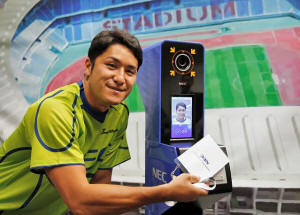|
Olympics: Tokyo 2020 to up security with facial recognition system
 Send a link to a friend
Send a link to a friend
 [August 07, 2018]
By Jack Tarrant [August 07, 2018]
By Jack Tarrant
TOKYO (Reuters) - Tokyo 2020 will be
the first Olympics to use facial recognition technology to increase
security around all venues, the organizers announced on Tuesday.
Games organizers have linked up with Japanese telecommunications and
information technology giant NEC to develop the first system of this
kind to be implemented at an Olympics.
The technology, which was demonstrated to the media at an event in
the Japanese capital, will use IC chips within identification cards
to automatically verify the identity of those entering over 40
venues.
More than 300,000 athletes and Games staff will have to submit
photographs to a database before the Olympics start in July 2020.
"Every time they enter the facility, they have to do a security
check," explained Tokyo 2020’s head of security Tsuyoshi Iwashita.

"Tokyo’s venues doesn’t always have enough space for the security
check or even space to wait for the security check. When the events
are happening, we expect many people to come and the weather will be
very hot. This is why we introduced this facial recognition."
The system will not be aimed at spectators and will instead
concentrate on strengthening security and decreasing waiting times
for athletes.
"More than 40 facilities, including the main stadium, International
Broadcast Centre, the Olympic village and so on, will have the
facial recognition system," said NEC vice president Masaaki Suanuma.
[to top of second column] |

NEC Green Rockets' rugby player Teruya Goto poses with the face
recognition system for Tokyo 2020 Olympics and Paralympics, which is
developed by NEC corp, during its demonstration in Tokyo, Japan
August 7, 2018. REUTERS/Toru Hanai

"Athletes, Games staff, volunteers and the media will have this
recognition."
NEC said they tested the technology during the Rio 2016 Olympics and
that the technology has already been implemented in various
locations, including airports.
During the demonstration to media, the technology correctly
identified a string of people, including those in wheelchairs and of
varying heights, which is a key feature of NEC’s system.
Suanuma said: "99.7 percent of the time, the face is recognized by
the system correctly.
"This number will not change according to nationality or if big or
small."
(Reporting by Jack Tarrant; Editing by Amlan Chakraborty)
[© 2018 Thomson Reuters. All rights
reserved.] Copyright 2018 Reuters. All rights reserved. This material may not be published,
broadcast, rewritten or redistributed.
Thompson Reuters is solely responsible for this content.
 |